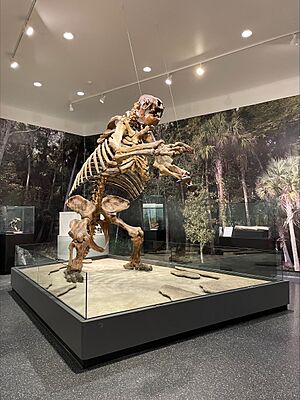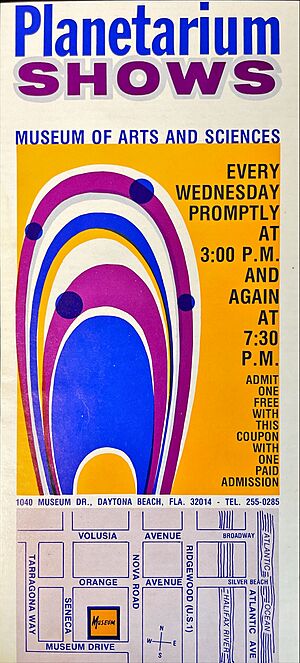Museum of Arts and Sciences (Daytona Beach) facts for kids
 |
|
| Lua error in Module:Location_map at line 420: attempt to index field 'wikibase' (a nil value). | |
| Location | 352 South Nova Road Daytona Beach, Florida |
|---|---|
| Type | Art, Science, History |
| Public transit access | Route 7, VOTRAN |
The Museum of Arts and Sciences, often called MOAS, is a cool museum in Daytona Beach, Florida. It's the main place in Central Florida to explore art, science, and history. MOAS gets support from the State of Florida and is connected to the famous Smithsonian Institution.
It's home to the Cici and Hyatt Brown Museum of Art, which has the biggest collection of Florida art in the world. You can also visit The Lowell and Nancy Lohman Planetarium, the only planetarium on Florida's Space Coast. With over 30,000 items, MOAS is one of the largest museums in central Florida.
Contents
Museum History
In 1954, people in Daytona Beach decided to create a children's museum. They called it "The Halifax Childrens Museum." It started in a special Quonset hut building at the Mary Karl Vocational School. The museum officially became a non-profit group the next year.
In 1961, the museum changed its name to the Museum of Arts and Sciences. It began teaching science and history to both kids and adults. This meant they needed a bigger space. So, in 1964, the museum moved to a new building in Daytona's Tuscawilla Preserve.
In 1972, the museum added a planetarium. This planetarium worked with the Volusia County School Board. It was like an extra classroom for students in the area.
In 1977, Gary Russell Libby became the museum's director. Under his leadership, the museum grew a lot. It became a member of the American Alliance of Museums and a Smithsonian Affiliate. The museum expanded from one small building to three different locations. When he retired in 2002, the museum named its lobby the "Gary R. Libby Entry Court."
The West Wing of the museum was rebuilt and opened again on October 30, 2015. This part of MOAS holds many interesting exhibits. These include the Cuban Foundation Museum and the Karshan Center of Graphic Art. It also has the Elaine and Thurman Gillespy Jr. Gallery with African items. You can also find the Marzullo Gallery with weapons from around the world. The Prehistory of Florida Gallery and the Charles and Linda William's Children's Museum are also in this wing.
Amazing Exhibits
The main museum building has 10 permanent exhibits. These exhibits show off Florida's natural history, African and Cuban cultures, and Florida art. They also cover many science topics.
Some cool exhibits you can see are:
- The most complete giant ground sloth (Eremotherium) skeleton in North America. You can find it in the Florida fossil gallery.
- The largest permanent display of Cuban art outside of Cuba.
- A collection of beautiful international decorative arts.
- Early American furniture and art.
- A gallery of Chinese art.
- Visible storage, where you can see many items not currently on display.
About half of the exhibits stay the same, but many change every few months. The museum also has its own theater, called the Root Hall auditorium. It can seat 265 guests for shows and events.
The Lowell and Nancy Lohman Planetarium
The MOAS Planetarium first opened its doors on October 11, 1972. One of its first shows was about a "trip to the Moon." This show happened during the Apollo 17 mission. That mission was the last time humans went to the Moon. It launched from Florida, just south of Daytona, in December 1972.
Since then, the Planetarium has followed many NASA missions. It has shown events from Pioneer 10's trip to Jupiter to the building of Skylab. It also covered the International Space Station and the current Artemis program to return to the Moon. In 2014, the Planetarium was rebuilt. It now has a modern digital projection system and a special exhibit area. In 2021, it was officially named the Lowell and Nancy Lohman Planetarium.
The Cici and Hyatt Brown Museum of Art
On May 7, 2012, the museum campus grew with a new building. This building was made to show Florida art. It is the permanent home for over 2,600 paintings of Florida. These paintings come from the collection of Cici and Hyatt Brown. This display is the largest collection of Florida art in the world.
Charles and Linda William's Children's Museum
MOAS opened the first science center for kids in the area on November 21, 2008. The Charles and Linda William's Children's Museum has many hands-on science exhibits. It is a large, modern space where kids can learn by doing.
The Children's Museum has fun, interactive exhibits. Kids can build their own vehicles at a raceway. There are also doctor and radiologist exhibits. You can use a video light microscope or play in a make-believe pizza parlor. All these exhibits help kids learn about science in a fun way.
The Root Family Museum
This exhibit shows the amazing collection of Chapman Root. He was a Coca-Cola entrepreneur. His collection includes two private rail cars. These are the 'Dell Rapids' and the 'Silver Holly'. You can also see Indy race cars that his family sponsored. The museum also has one of the biggest collections of historic Coca-Cola items in the world. It includes original molds and patents for the famous bottle.
Gamble Place
Away from the main museum, MOAS also takes care of Gamble Place. This is a historic area found within the Spruce Creek Preserve. This property shows off Florida's beautiful natural environment. It also tells a unique story through its three historic house museums.
Gamble Place is a large park with trails. It covers five different types of natural areas. It is also home to many animals and plants that are rare or in danger.
Klancke Environmental Education Complex
In 2005, MOAS opened the Kim A. Klancke, M.D. & Marsha L. Klancke Environmental Education Complex. This complex is in Tuscawilla Preserve. The preserve is a large nature area in the middle of Daytona Beach. It has over half a mile of boardwalks and nature trails. This preserve protects a special type of Florida forest called a hammock. It is also a home for rare plants and animals.
See also
 In Spanish: Museo de las Artes y las Ciencias (Daytona Beach) para niños
In Spanish: Museo de las Artes y las Ciencias (Daytona Beach) para niños



